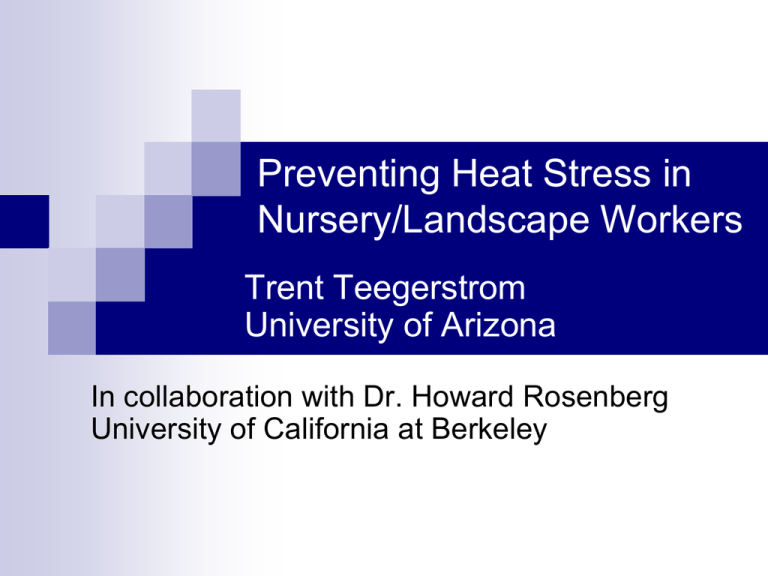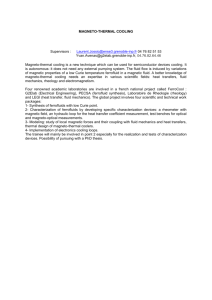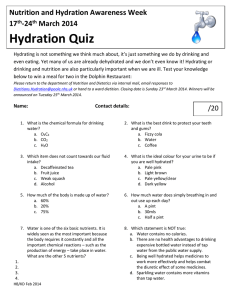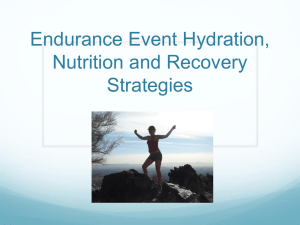Preventing Heat Stress in Nursery/Landscape Workers Trent Teegerstrom
advertisement

Preventing Heat Stress in Nursery/Landscape Workers Trent Teegerstrom University of Arizona In collaboration with Dr. Howard Rosenberg University of California at Berkeley Outline Basics of how heat stress affects the body Conditions caused by heat stress Controlling heat stress Practical issues for nursery/landscape How to prevent heat stress in workers Heat stress (total net heat load on the body) = heat from external sources (environmental) plus (+) internally generated heat (metabolic) minus (-) heat lost from the body to the environment Physiology of heat stress During both rest and activity, the human body tries to maintain an internal temperature of 98.6 F. Hot weather, heat sources, and hard work raise the body’s core temperature. Heated blood is pumped to the skin’s surface where excess body heat is lost to the cooler outside environment. If more heat needs to be shed, the evaporation of sweat aids in cooling. During heavy work, a person can lose 1- 2 liters of water per hour. After 2-3 hrs a person may loose endurance, become uncomfortable, feel hot and become thirsty. Physiology of heat stress (continued) The longer a body sweats, the less blood there is to shed excess heat or carry oxygen and nutrients to muscles. After 3 hours, a dehydrated worker may experience: Headaches, muscle fatigue, loss of strength, loss of accuracy and dexterity, heat cramps, reduced alertness, nausea Water is key to cooling the body and counteracting heat stress. Without fluid replacement during an extended period of work, the body may be in serious danger. Untreated heat exhaustion may lead to heat stroke. Heat stress effects if no fluid is replaced Dehydration Cumulative Fluid Loss Minor Dehydration 1.5 lb. (.75 L) % Body Wt. 1% Time to Reach* 1 hr Symptoms and Effects Generally unperceived Incipient Stress 3.0 lb. (1.5 L) 2% 2 hr Begin thirsty, hot, minor discomfort . Advanced Stress 4.0 lb. (2.25 L) 3% 3 hr Loss of energy, muscle endurance. Heat Cramping 6-9 lb. (3-4 L) 4-6% 4-5 hr Impaired coordination, endurance. Less energy, strength. Fatigue, cramps. Heat Exhaustion 9-12 lb. (4-5.5 L) 6-8% 6-7 hr Headache, dizziness, nausea. Serious fatigue. Heat Stroke 11+ lb. (5+ L) 7+ hr High body temperature, confusion. Loss of consciousness. 7+% * based on a 150 lb. male performing moderately active work in hot weather and not drinking to replace fluids Summary The physiological responses of the body to heat are: Increase in “core” body temperature Increase in heart rate Increase in blood flow to the skin Loss of water and salt (sweating) Heat illness that impairs cooling mechanisms Environmental factors that affect body heat gain and loss Air Temperature Air Movement Humidity Radiant Heat Altitude NWS Heat Index Average high temperatures in AZ + CA (Average annual high temperatures for each month @ 40% humidity) May Jun Jul Aug Sep Oct Phoenix 93 101 104 103 99 89 Tucson 91 99 99 98 95 86 Flagstaff 68 78 82 79 74 71 Yuma 94 102 106 105 102 91 Prescott 74 85 88 86 81 71 Bakersfield 84 92 98 96 90 80 El Centro 94 104 108 106 101 90 Personal factors affecting tolerance Activity level (metabolic heat) Fluid intake and electrolyte replenishment Alcohol and drug use ```````````````````````````````` Acclimatization Age Physical fitness Body fat Diet Issues exacerbating heat stress in the nursery and landscape industries Unconditioned environment High temperatures and humidity Physically demanding work Misread as or combined with pesticide exposure “Costs” of access to water Causes of Serious Injury in AZ Nursery and Agriculture Industries 2001-02 Caught or struck by equipment (32%) Machinery and vehicles operation (26%) Overexertion (21%) (including heat stress) Falls (11%) Other (25%) electrical, chemical, livestock Other Hazards of Heat Stress Besides the medical hazards of illness or injury caused by heat stress, there is also a higher frequency of accidents in hot environments. Direct causes of accidents: Sweat in the eyes Slippery hands Fogged glasses Dizziness or fainting Indirect causes of accidents: Physical discomfort Slower mental and physical job reactions Diverting attention from the job Lapse in judgment Irritability and anger Heat and Pesticide Exposure Symptoms of organophosphate and carbamate pesticide exposure are similar to those of heat stress How much misdiagnosis ? Symptom Comparison Heat Stress Sweating Headache Fatigue Dry membranes Faster pulse Nausea Dilated pupils CNS effects Coordination loss Confusion Fainting Pesticide Exposure Sweating Headache Fatigue Most membranes ok Slower pulse Nausea and diarrhea Small or normal pupils CNS effects Coordination loss Confusion Coma Coping with the Hazards Planning, training, and supervision are key to preventing heat disorders Understand the effects of heat stress Know the symptoms and treatments Take personal precautions . . . . Preventive Measures to Consider Consider current and predicted weather conditions, issue heat-alert if necessary Evaluate and modify work assignments Adjust rest period frequency and length Schedule heavier jobs for cooler hours Provide shade for stationary work Help workers become acclimatized Medical exam to identify need for accommodation Train / educate -- recognition, treatment, physiology Use cooling garments Find lighter weight protective gear Provide cool places for breaks Improve fluid replenishment Providing shade for stationary tasks such as filling pots with media can help mitigate exposure to heat. Fluid Replacement Guidelines U.S. Military & NIOSH Research: 25 oz./hr. during moderate work at 82-90 F 33 oz./hr. during heavy work at >90 F Drink small amounts frequently (drip, not flood) Don’t wait for thirst Rest every hour: “Rest means minimal physical activity such as sitting or standing. The following examples will vary depending on individual and circumstances) Moderate work in moderate heat (85-89 F) work/rest 40/20 min Moderate work in High heat (>90 F) work/rest 20/40 min Hard work in moderate heat (85-89 F) work/rest 30/30 min Hard work in high heat (>90 F) work/rest 10/50 min Do current means of providing water effectively address risk of heat stress? Drip vs. Flood Irrigation in Sport Personal hydration systems enable cyclists to hydrate on the move. Cyclists can keep going, save time, and maintain high speed. Exercise research shows increases in fluid consumption and performance using a hydration system vs. traditional container. Employer testimonies: O’Reilly Auto Parts . . . Warehouse piece rate work environment. Field test initiated by the Risk Manager ... “The use of a CamelBak hydration system has increased our productivity by 20%.” Berry producer in Oxnard . . . Agricultural workers in the field. Field test initiated by the Safety manager. “Every single person that used a CamelBak hydration system in our study -- 100% of them -- had an increase in productivity. Casual Observations: Water Availability versus Intake Igloo is state of the art for many field operations. Workers walk to reach water, distance varies. Costs to access water are not only physical. Infrequent visits to igloo are thirst-driven. Large quantities are then drunk at each visit. Less access taken while on piece-rate basis. Faster pace of work in the morning. Workers have little understanding of how heat affects the human body. Are workers chronically underhydrated and show subacute symptoms of heat stress? OSHA General Duty “...every employer covered under the Act furnish to his employees employment and a place of employment which are free from recognized hazards that are causing or are likely to cause death or serious physical harm to employees.” “Ideal Heat Stress Standard” Simple Inexpensive to implement No interference with production Easy to enforce Recommended Training Objectives: Enable Workers to . . . . understand how a body responds to heat, function of the body’s cooling system, factors that affect body heat gain or loss, and effects of heat stress. know and effectively use prevention measures. describe causes and symptoms, and be able to give initial aid to others with minor heat stress disorders. describe the causes and symptoms, and be able to give or obtain first aid for others with major heat stress disorders. Additional Resources Heat Stress in Agriculture, U.S. EPA http://are.berkeley.edu/heat/ Cal/OSHA Advisory Committee bbarish@hq.dir.ca.gov



